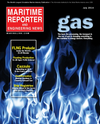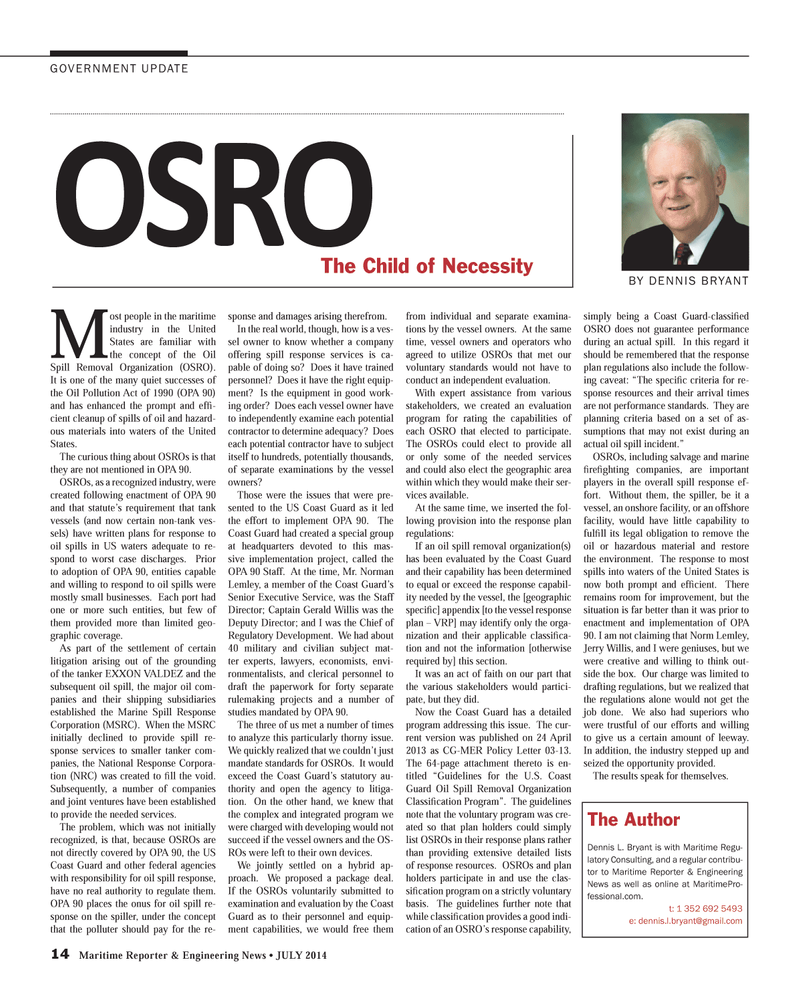
Page 14: of Maritime Reporter Magazine (July 2014)
Offshore Energy Structures & Systems
Read this page in Pdf, Flash or Html5 edition of July 2014 Maritime Reporter Magazine
14 Maritime Reporter & Engineering News • JULY 2014
GOVERNMENT UPDATE
M ost people in the maritime industry in the United
States are familiar with the concept of the Oil
Spill Removal Organization (OSRO).
It is one of the many quiet successes of the Oil Pollution Act of 1990 (OPA 90) and has enhanced the prompt and effi - cient cleanup of spills of oil and hazard- ous materials into waters of the United
States.
The curious thing about OSROs is that they are not mentioned in OPA 90.
OSROs, as a recognized industry, were created following enactment of OPA 90 and that statute’s requirement that tank vessels (and now certain non-tank ves- sels) have written plans for response to oil spills in US waters adequate to re- spond to worst case discharges. Prior to adoption of OPA 90, entities capable and willing to respond to oil spills were mostly small businesses. Each port had one or more such entities, but few of them provided more than limited geo- graphic coverage.
As part of the settlement of certain litigation arising out of the grounding of the tanker EXXON VALDEZ and the subsequent oil spill, the major oil com- panies and their shipping subsidiaries established the Marine Spill Response
Corporation (MSRC). When the MSRC initially declined to provide spill re- sponse services to smaller tanker com- panies, the National Response Corpora- tion (NRC) was created to fi ll the void.
Subsequently, a number of companies and joint ventures have been established to provide the needed services.
The problem, which was not initially recognized, is that, because OSROs are not directly covered by OPA 90, the US
Coast Guard and other federal agencies with responsibility for oil spill response, have no real authority to regulate them.
OPA 90 places the onus for oil spill re- sponse on the spiller, under the concept that the polluter should pay for the re- sponse and damages arising therefrom.
In the real world, though, how is a ves- sel owner to know whether a company offering spill response services is ca- pable of doing so? Does it have trained personnel? Does it have the right equip- ment? Is the equipment in good work- ing order? Does each vessel owner have to independently examine each potential contractor to determine adequacy? Does each potential contractor have to subject itself to hundreds, potentially thousands, of separate examinations by the vessel owners?
Those were the issues that were pre- sented to the US Coast Guard as it led the effort to implement OPA 90. The
Coast Guard had created a special group at headquarters devoted to this mas- sive implementation project, called the
OPA 90 Staff. At the time, Mr. Norman
Lemley, a member of the Coast Guard’s
Senior Executive Service, was the Staff
Director; Captain Gerald Willis was the
Deputy Director; and I was the Chief of
Regulatory Development. We had about 40 military and civilian subject mat- ter experts, lawyers, economists, envi- ronmentalists, and clerical personnel to draft the paperwork for forty separate rulemaking projects and a number of studies mandated by OPA 90.
The three of us met a number of times to analyze this particularly thorny issue.
We quickly realized that we couldn’t just mandate standards for OSROs. It would exceed the Coast Guard’s statutory au- thority and open the agency to litiga- tion. On the other hand, we knew that the complex and integrated program we were charged with developing would not succeed if the vessel owners and the OS-
ROs were left to their own devices.
We jointly settled on a hybrid ap- proach. We proposed a package deal.
If the OSROs voluntarily submitted to examination and evaluation by the Coast
Guard as to their personnel and equip- ment capabilities, we would free them from individual and separate examina- tions by the vessel owners. At the same time, vessel owners and operators who agreed to utilize OSROs that met our voluntary standards would not have to conduct an independent evaluation.
With expert assistance from various stakeholders, we created an evaluation program for rating the capabilities of each OSRO that elected to participate.
The OSROs could elect to provide all or only some of the needed services and could also elect the geographic area within which they would make their ser- vices available.
At the same time, we inserted the fol- lowing provision into the response plan regulations:
If an oil spill removal organization(s) has been evaluated by the Coast Guard and their capability has been determined to equal or exceed the response capabil- ity needed by the vessel, the [geographic specifi c] appendix [to the vessel response plan – VRP] may identify only the orga- nization and their applicable classifi ca- tion and not the information [otherwise required by] this section.
It was an act of faith on our part that the various stakeholders would partici- pate, but they did.
Now the Coast Guard has a detailed program addressing this issue. The cur- rent version was published on 24 April 2013 as CG-MER Policy Letter 03-13.
The 64-page attachment thereto is en- titled “Guidelines for the U.S. Coast
Guard Oil Spill Removal Organization
Classifi cation Program”. The guidelines note that the voluntary program was cre- ated so that plan holders could simply list OSROs in their response plans rather than providing extensive detailed lists of response resources. OSROs and plan holders participate in and use the clas- sifi cation program on a strictly voluntary basis. The guidelines further note that while classifi cation provides a good indi- cation of an OSRO’s response capability, simply being a Coast Guard-classifi ed
OSRO does not guarantee performance during an actual spill. In this regard it should be remembered that the response plan regulations also include the follow- ing caveat: “The specifi c criteria for re- sponse resources and their arrival times are not performance standards. They are planning criteria based on a set of as- sumptions that may not exist during an actual oil spill incident.”
OSROs, including salvage and marine fi refi ghting companies, are important players in the overall spill response ef- fort. Without them, the spiller, be it a vessel, an onshore facility, or an offshore facility, would have little capability to fulfi ll its legal obligation to remove the oil or hazardous material and restore the environment. The response to most spills into waters of the United States is now both prompt and effi cient. There remains room for improvement, but the situation is far better than it was prior to enactment and implementation of OPA 90. I am not claiming that Norm Lemley,
Jerry Willis, and I were geniuses, but we were creative and willing to think out- side the box. Our charge was limited to drafting regulations, but we realized that the regulations alone would not get the job done. We also had superiors who were trustful of our efforts and willing to give us a certain amount of leeway.
In addition, the industry stepped up and seized the opportunity provided.
The results speak for themselves.
OSRO
The Child of Necessity
BY DENNIS BRYANT
The Author
Dennis L. Bryant is with Maritime Regu- latory Consulting, and a regular contribu- tor to Maritime Reporter & Engineering
News as well as online at MaritimePro- fessional.com. t: 1 352 692 5493 e: [email protected]
MR #7 (10-17).indd 14 6/30/2014 10:30:10 AM

 13
13

 15
15
